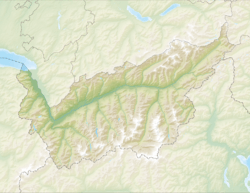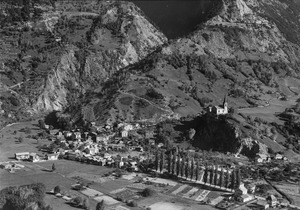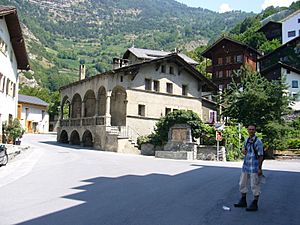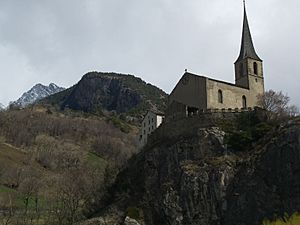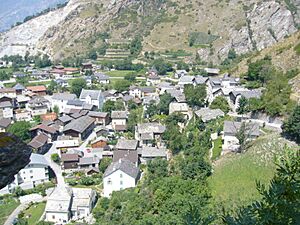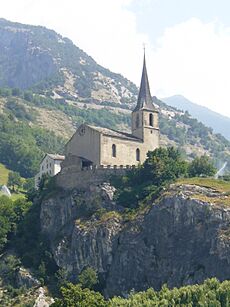Raron facts for kids
Quick facts for kids
Raron
|
||
|---|---|---|
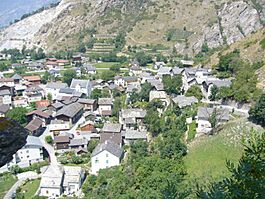 |
||
|
||
| Country | Switzerland | |
| Canton | Valais | |
| District | Raron | |
| Area | ||
| • Total | 30.37 km2 (11.73 sq mi) | |
| Elevation | 638 m (2,093 ft) | |
| Population
(Dec 2020 )
|
||
| • Total | 1,949 | |
| • Density | 64.175/km2 (166.21/sq mi) | |
| Postal code |
3942
|
|
| Surrounded by | Ausserberg, Baltschieder, Blatten (Lötschen), Bürchen, Niedergesteln, Unterbäch, Visp, Wiler (Lötschen), Zeneggen | |
Raron (also called Rarogne in French) is a small town in the Valais region of Switzerland. It's known for its interesting history and beautiful churches built on hills. Raron is located in a valley on the right side of the Rhone river.
Contents
History of Raron
Raron was first mentioned in old writings between 1101 and 1200. It was called Rarogni back then. Later, in 1146, it was known as Rarun.
People have lived in the Raron area for a very long time! Archeologists have found signs of settlements from the Neolithic period (the New Stone Age) all the way to the La Tène culture (the late Iron Age). These early settlements were found on a hill called Heidnischbiel and at a burial ground nearby. However, it seems people left the area during the Roman times.
Towers and Fortifications
During the Middle Ages (around the 12th century), a hill west of Heidnischbiel was fortified. This means it was made stronger with defenses. The Viztum tower house was built there. A Viztum was like a local governor or administrator. Important families like Raron, Asperlin, and de Chevron-Villette held this position.
In 1417, during a conflict called the Raron affair, the Viztume tower was partly destroyed. The town bought it in 1538 and used it as a town hall and even a jail. Today, it's privately owned. Another tower, the Meier tower, was built in the 13th century and was mostly used by the Asperlin family. Raron was quite important in local politics, and some bishops and governors came from here.
Churches of Raron
The main church area was probably first in St. German, with a church existing since the 8th or 9th centuries. By 1299, the church in Raron became the main church for the area.
In 1494, a flood from the Bietschbach river destroyed most of the Church of St. Romanus, except for its tower. This tower stayed until 1938. Later, between 1508 and 1514, the empty Meier tower was turned into a beautiful Gothic church. This new church was also dedicated to St. Romanus. In the 1970s, this old castle church was replaced by a modern "rock church" built at the foot of the hill in 1974.
Many large stone houses in Raron show how wealthy the town was in the 17th and 18th centuries. These include the Maxenhaus, Zentriegenhaus, and Zmilacherhaus. Raron became rich because of trade passing through the St. German pass to Visp. However, when a new road was built on the other side of the valley in the 19th century, Raron lost this income.
Modern Raron
In the 20th century, Raron grew into a modern town with industries and small businesses. In the 1940s, a military airfield was built for the Swiss Air Force, which even had an aircraft cavern (a hidden hangar inside a mountain!). This airfield was closed in 1994. Later, in 1980, Air Zermatt, a helicopter company, set up a base in Raron. The south entrance of the Lötschberg Base Tunnel, a very long railway tunnel, opened near the village in 2007.
Today, many people who live in Raron work in nearby towns like Visp, Brig, and Steg. Raron is also known for its special plays about the Passion of Christ and the Rosary.
Geography
Raron covers an area of about 30.3 square kilometers (about 11.7 square miles). A small part of this land (15.5%) is used for farming, and 19.0% is covered by forests. About 4.8% of the land has buildings or roads, while most of it (60.7%) is unproductive land like mountains.
The town of Raron is the main center of the Westlich Raron district. It includes the villages of Raron and Sankt German, plus smaller settlements called hamlets like Turtig and Rarnerchumma. It's located in the Rhone valley, near the entrance to the Bietsch valley, and west of Visp.
Coat of Arms
The blazon (description) of Raron's coat of arms is: Red, with a golden vine (plant) that has been pulled up by its roots, with green leaves and golden fruit.
Population and People
Raron has a population of about 1,896 people. Around 12.4% of the people living in Raron are from other countries. Over the past ten years (2000–2010), the population has grown a little.
Most people in Raron (about 91.7%) speak German as their main language. Other languages spoken include Albanian (2.9%) and French (2.0%).
In 2008, about 50.9% of the population was male and 49.1% was female. Many people (about 50.8%) were born in Raron and still lived there in 2000.
The population of Raron is made up of:
- Children and teenagers (0–19 years old): 25%
- Adults (20–64 years old): 61.4%
- Seniors (over 64 years old): 13.6%
The chart below shows how Raron's population has changed over time:

Important Heritage Sites
Some places in Raron are so important that they are listed as heritage sites of national significance. These include:
- The prehistoric site of Heidnischbühl.
- The Church of St. Roman with its old Rectory (the priest's house).
- The Viztume tower house.
The whole village of Raron, the hamlet of Rarner Chumma, and the Turtig/Wandfluh area are also part of the Inventory of Swiss Heritage Sites.
Economy and Jobs
In 2010, Raron had a low unemployment rate of 1.7%. This means most people who wanted to work had jobs.
People in Raron work in different types of jobs:
- Primary sector: About 76 people work in farming and forestry.
- Secondary sector: About 442 people work in manufacturing (making things) and construction (building things).
- Tertiary sector: About 254 people work in services, like sales, transportation, hotels, restaurants, and education.
Many people who live in Raron travel to other towns for work. About 55.1% of the working population uses a private car to get to work, while 22.3% use public transportation.
Religion
Based on a 2000 survey, most people in Raron (85.8%) are Roman Catholic. About 3.3% belong to the Swiss Reformed Church. There are also smaller numbers of people who are Orthodox Christian, other Christians, or Muslim. Some people do not belong to any church.
Education
In Raron, about 38.7% of the population has finished upper secondary education (like high school). About 7.1% have gone on to higher education, such as university.
During the 2010-2011 school year, Raron had 289 students.
- There were 37 kindergarten students in 2 classes.
- There were 167 primary school students in 9 classes.
- There were 122 lower secondary students.
Students who go to advanced high schools (upper secondary) usually attend schools in other towns.
Notable Residents
The famous poet Rainer Maria Rilke is buried in the cemetery of the old church in Raron.
See also
 In Spanish: Raroña para niños
In Spanish: Raroña para niños




